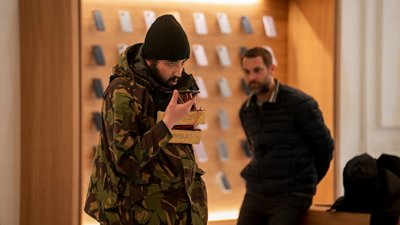Apple recently introduced a new cursor experience in iPadOS — one that software engineering chief Craig Federighi says was by necessity a combination of how users interface with the Mac, and the Apple TV.
The iPadOS cursor was launched alongside mouse and trackpad support in iPadOS 13.4 and the new iPad Pro Magic Keyboard. Rather than adding an exact duplicate of the macOS cursor, Apple designed the new user experience from the ground up for iPad.
Apple senior vice president of software engineering Craig Federighi recently sat down with TechCrunch to explain how it did so.
"There was a process to figure out exactly how various elements would work together. We knew we wanted a very touch-centric cursor that was not conveying an unnecessary level of precision," Federighi said.
As part of that development, Apple took advantage of a "focus experience" similar to the Apple TV. The company also worked to provide a "greater sense of feedback" for users when dealing with text.
"Part of what I love so much about what's happened with iPadOS is the way that we've drawn from so many sources," Federighi explained. "The experience draws from our work on tvOS, from years of work on the Mac, and from the origins of iPhone X and early iPad, creating something new that feels really natural for iPad."
It's also worth noting that the same core design team responsible for the iPadOS cursor was also the team that worked on the Apple TV interface.
Going into the development, Federighi said that the team wanted the iPadOS cursor to "reflect the natural and easy experience of using your finger when high precision isn't necessary" but was able to transition into high precision tasks like editing text.
So Federighi and the team came up with the circle that transforms depending on the context — such as the focus around a button, or the I-beam when dealing with text.
"We set out to design the cursor in a way that retains the touch-first experience without fundamentally changing the UI," Federighi said. That means it can adapt to customers who never use a trackpad on iOS, or those who switch back and forth between touch and trackpad.
The Apple SVP of software also detailed some of the work on the iPad trackpad gestures, stating that many of them are "analogous to those on the Mac."
Because of that, users won't "have to think about them or relearn anything," but Federighi noted that the gestures "respond in a different, more immediate way on iPad, making everything feel connected and effortless."
Although the cursor and trackpad support in iPadOS were released alongside Apple's proprietary magic keyboard, third-party accessories from manufacturers like Brydge and Logitech are also compatible.
 Mike Peterson
Mike Peterson







-m.jpg)






 Christine McKee
Christine McKee
 Malcolm Owen
Malcolm Owen

 Charles Martin
Charles Martin


 Mike Wuerthele
Mike Wuerthele



-m.jpg)






25 Comments
iPad OS is the new macOS.
So, for the first time in ten years I’ve got a keyboard for my iPad. I bought the first keyboard for the first iPad back in May 2010, when you had to plug the iPad into the 30 pin connector of the keyboard, vertically, because that’s where the connectors are. Didn’t buy a keyboard for it since, though occasionally I would use an extra wireless Mac keyboard I had lying around for the Apple TV.
so now I have the new folio keyboard/case. The new Brydge Pro +, with trackpad, and the Magic Keyboard. Whew!
they all work as expected. The Brydge cursor can be just a tiny bit jerky at times, but not as annoying as some reports make it sound. The lag is really very small. While it doesn’t exactly support all of Apple’s gestures out of the box right now, they announced a firmware update for this that I imagine will fix that. Since the Brydge was developed and built before the Magic Keyboard was announced, there was no way for it to support gestures it didn’t know about. Some commentators seem to be very ignorant about the way development works, and wrote their articles and reviews as though that was a permanent defect, which it wasn’t.
one thing I can now express my annoyance about that involves all three keyboards, because at first I thought it might just be the way the Folio worked, Is that none of them seem to be able to recognize that the word “I” needs to be capitalized. Sometimes they do it, and sometimes they don’t. The onscreen keyboard, which I’m typing on now, doesn’t have that problem. It’s not just the “I” either. They work more like the Mac keyboard in this regard than the virtual iPad keyboard, and that’s disappointing, because I’m used to the way that works, now having used them for ten years.
but then, for several iOS upgrades, the text replacement has been wonky altogether. Sometimes words I have set in there work, and sometimes not. It stopped working properly somewhere around iOS 10.